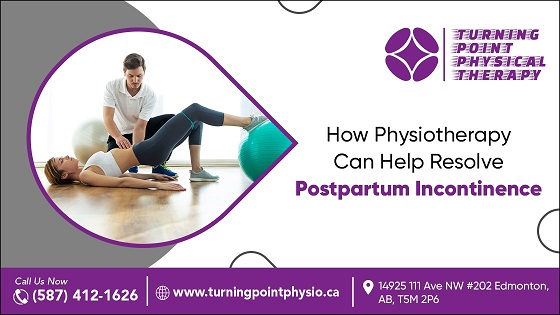Postpartum incontinence is a common yet often under-discussed issue that affects many women after childbirth. The physical strain during delivery weakens pelvic floor muscles and leads to urinary incontinence. Fortunately, pelvic floor physiotherapy in Edmonton offers practical, evidence-based solutions to help new mothers regain control and improve their quality of life. This guest blog will explore how physiotherapy can address postpartum incontinence, including techniques and exercises that can make a significant difference.
Understanding the Types of Incontinence
Incontinence, the involuntary urine leakage, affects many individuals and can significantly impact daily life. Here’s a brief overview:
- Stress Incontinence:
Weakened pelvic floor muscles, often due to pregnancy, childbirth, menopause, or prostate surgery, can lead to leakage during physical activities like coughing, sneezing, or exercising. It is common following vaginal childbirth. - Urge Incontinence:
Overactive bladder muscles, neurological disorders, infections, or bladder irritants can cause a sudden, intense urge to urinate, followed by leakage. Scar tissue from C-sections can pull on the bladder and make women need to go more frequently.
Understanding Postpartum Incontinence
Postpartum incontinence primarily results from the weakening or damage of the pelvic floor muscles during pregnancy and childbirth. It supports the bladder, uterus, and bowel to maintain continence. Factors contributing to postpartum incontinence include:
- Vaginal delivery: The process of giving birth can stretch and strain the pelvic floor muscles.
- Perineal tears or episiotomy: Tears or surgical cuts in the perineum can weaken the muscles.
- Hormonal changes: Pregnancy hormones can affect muscle tone and elasticity.
- Instrumental delivery: Use of forceps or vacuum during delivery can increase the risk of muscle damage.
The Role of Physiotherapy In Postpartum Incontinence
Female pelvic floor physiotherapy in Edmonton offers a comprehensive approach to treating postpartum incontinence by strengthening pelvic floor muscles to improve bladder control. Here are some effective techniques and exercises used by physiotherapists:
1. Biofeedback
Biofeedback is a technique used in pelvic health physiotherapy to help women become more aware of pelvic floor muscle activity. During biofeedback sessions, sensors are placed on the body to monitor muscle contractions. The feedback on a screen helps patients understand how to perform exercises correctly and track their progress.
2. Pelvic Floor Muscle Training (PFMT)
Pelvic floor muscle training, known as Kegel exercises, is the cornerstone of postpartum exercises. PFMT involves repeatedly contracting and relaxing the pelvic floor muscles to build strength and endurance.
- Find a Comfortable Position: PFMT can performed lying down, sitting, or standing. For new mothers experiencing postpartum incontinence, lying down at first may be more manageable as it eliminates the effects of gravity, allowing better concentration on the pelvic floor muscles.
- Tighten the Muscles: Squeeze the pelvic floor muscles and hold the contraction for three seconds. Avoid tightening the abdominal, buttock, or thigh muscles to ensure the exercise targets the pelvic floor muscles affected explicitly by childbirth.
- Relax the Muscles: Fully relax the pelvic floor muscles for three seconds. This relaxation phase is crucial for muscle recovery and preparation for the next contraction, essential to postpartum recovery.
- Repeat: Perform the contraction and relaxation cycle for three sets of 10-15 repetitions daily. As the pelvic floor muscles strengthen, gradually increase the hold time from three seconds to five and up to ten seconds. This progressive strengthening is vital for improving postpartum incontinence.
3. Bladder Training
Bladder training involves developing a scheduled voiding routine to increase bladder capacity and reduce the frequency of incontinence episodes. A physiotherapist can help create a personalized schedule, gradually increasing the time between voids.
- Establish a Baseline: Keep a bladder diary for a few days to record the times of urination, any instances of leakage, and the amount of fluid intake. It will help establish a baseline of your current bladder habits.
- Create a Voiding Schedule: A physiotherapist can help you create a personalized voiding schedule based on the bladder diary. This schedule typically starts with short intervals between bathroom trips (e.g., every hour) and gradually increases.
- Gradual Interval Extension: Start by adhering to the initial schedule, even if you don’t want to urinate. Gradually increase the time between voids by 15-30 minutes each week, aiming to extend the intervals to 2-3 hours over several weeks.
- Use Distraction Techniques: When the urge to urinate arises before the scheduled time, use distraction techniques such as deep breathing, pelvic floor muscle contractions, or engaging in a different activity to delay urination.
- Fluid and Diet Management: Avoid excessive fluid intake and reduce consumption of bladder irritants such as caffeine, alcohol, and spicy foods. Staying hydrated is essential, but spread your fluid intake evenly throughout the day.
Achieve Postpartum Wellness With Professional Physiotherapy Care
Postpartum incontinence can significantly impact a new mother’s quality of life, but it is a treatable condition. Physiotherapy offers a range of practical, evidence-based techniques and exercises to help women regain control and confidence. Experienced physiotherapists provide personalized care and support for postnatal physiotherapy care. By incorporating pelvic floor physiotherapy in Edmonton, we help new mothers on their journey to recovery and improved well-being.
For more information or to schedule a consultation, contact Turning Point Physiotherapy in Edmonton today. Together, we can help you regain control and enjoy motherhood fully.
Read More: Evolving Care: Anticipating the Landscape of Medicare Advantage Plans in 2025

